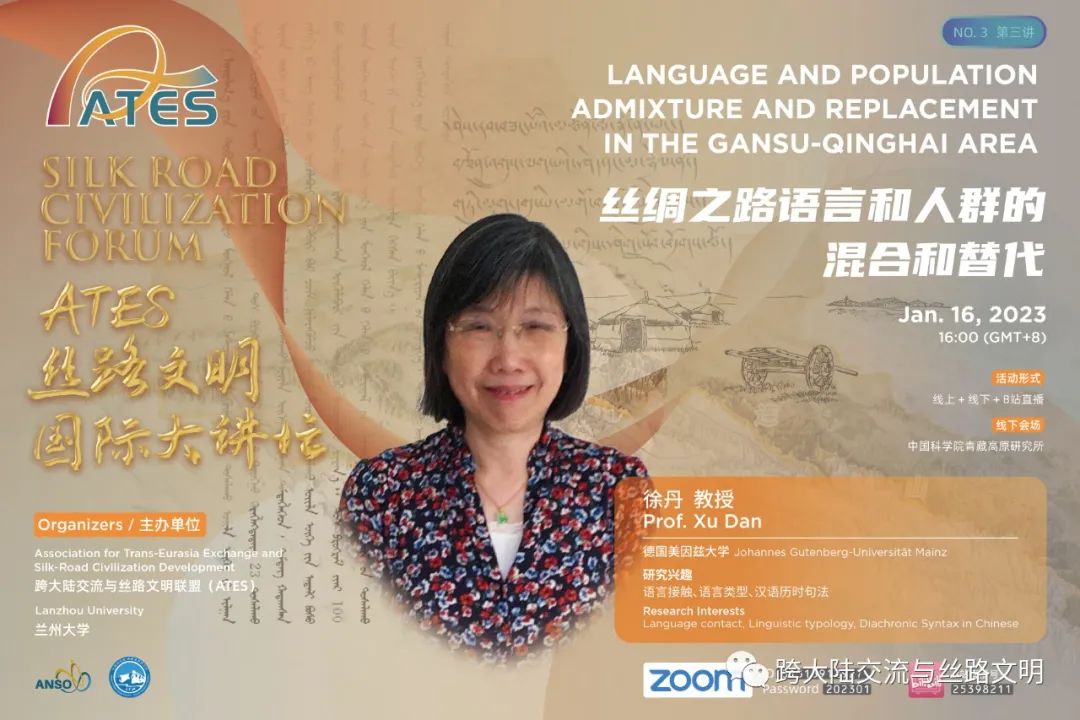The Silk Road is an important channel connecting Eastern and Western exchanges and the spread of people, and China's Ganqing region is an important node on the Silk Road. In this report, we will invite Professor Xu Dan of the University of Mainz, Germany, to share her research results on the history of language evolution and population migration in Qinghai, Gansu Province, and take the Dongxiang and Baoan ethnic groups as examples to explain the specific manifestations of the "elite-led" and "culturally led" models in the region. The report time is about 1 hour, and the report review and interaction are set up after the report is completed. Interested teachers and students are welcome to participate in the conference.
Reporter:Professor Xu Dan
Title:Mixing and substitution of languages and populations along the Silk Roads
Time:January 16, 2023, 16:00-18:00
Activity Format: online zoom + B station live broadcast
ZOOM ID:813 1391 2927,Password:202301
Bilibili Live Broadcast Number:25398211

Lecturer profiles
Xu Dan, female, is a 77th-grade student at Beijing Foreign Chinese University (now Beijing Foreign Chinese University). Ph.D. in Linguistics, University of Solbon, France. Part-time researcher at the Institute of East Asian Languages (CRLAO), France's National Research Center. She was a special professor at the Institut National de l'Oriental Languages and Cultures (INALCO). She is currently a professor at the University of Mainz, Germany. In October 2009, she was elected a member of the Membre Senior de l'Institut Universitaire de France (IUF) and in 2021 she was elected a member of the Academia Europaea. She has presided over different international cooperation projects. The EU project currently being hosted is ERC-2019-AdG 883700-TRAM Tracing language and population mixing in the Gansu-Qinghai area. Research interests, language contact, language types, Chinese diachronic syntax.
ATES Silk Road Civilization International Forum Series Background Introduction:ATES is a scientific research alliance composed of scholars and experts from a number of scientific research institutions from Asia, Europe, America, and other regions to carry out research on climate and environmental changes, Paleolithic culture, Neolithic culture, historical geography, environmental archaeology, technical archaeology, etc., aiming to understand Paleolithic culture and human diffusion, Neolithic civilization and agricultural spread, road network and urban changes, Silk Road scientific and technological exchanges. For major scientific issues such as environmental change and the evolution of Silk Road civilization, five working groups should be set up to coordinate international exchanges and cooperation in related specialties, form an international scientific research alliance with substantive cooperation, provide historical reference for sustainable development along the Silk Road, and serve the national "Belt and Road" initiative with science and technology. In order to further enhance the international influence of the ATES Alliance, strengthen exchanges and interactions with cutting-edge first-class scientists in related research fields, and promote the construction of an international cooperation platform for the research of Silk Road civilizations, the ATES Alliance and the Institute of Tibetan Plateau Research of the Chinese Academy of Sciences took the lead and jointly launched the "ATES Silk Road Civilization International Forum" activity in conjunction with other ATES partners. The forum is a series of high-level academic reports, held every 3 months, each forum will invite a scientist with international influence in climate and environmental change, environmental archaeology, archaeology, history, and other related academic fields to make reports and interactive exchanges, promote interdisciplinary integration, improve the overall level of the research field of Silk Road civilization, and serve the national "Belt and Road" initiative with science and technology.